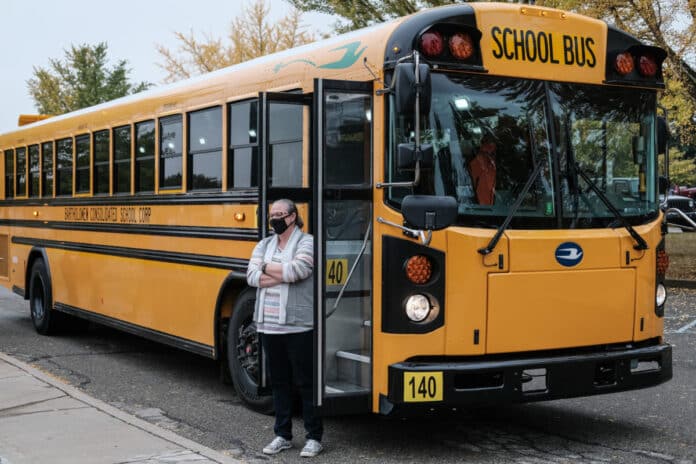
Usually, memories of riding a school bus brings to mind certain sensory details — rattling machinery, sudden stops and hazy gray smoke wafting out of the tailpipe.
However, for riders of the district’s new all-electric Blue Bird school bus, those experiences are a thing of the past.
On Tuesday, the Bartholomew Consolidated School Corp. showcased the new bus, which started running routes to Columbus East High School and Richards Elementary on Oct. 12.
When the vehicle pulled up in front of the elementary school for Tuesday’s media event, there was hardly a sound except for a gentle hum from the bus and the soft splash of its tires gliding through puddles.
Richards Elementary students who ride on the bus said that it’s noticeably more smooth and quiet than what they’re used to.
“It feels good,” said fourth-grader Khloe Blackwell. “I like it a lot. Because everybody on our bus is like, ‘I want to keep this! I want to keep the bus! I want to keep it!’”
The bus driver, Shannon Stuart, also appreciates the change.
“I love it,” she said. “I can hear the students. I can hear other things, like sirens, you know. And I feel like it’s a lot safer, as far as the noise is concerned.”
Brett Boezeman, director of operations at BCSC, called the bus “the second electric school bus in the state” and “the first in the region.”
The total cost of the bus is around $423,000, he said. Of this cost, $315,000 came from a grant from the Indiana Volkswagen Environmental Mitigation Trust Fund Committee. Monroe, Carroll and Hamilton counties also received funding to purchase one all-electric bus, according to a release from the Indiana Department of Environmental Management.
Part of the cost of the new bus was covered by Cummins, Boezeman said, and BCSC covered the difference, which was about $17,000. He added that the bus’s entire powertrain and the majority of its mechanical parts come from Cummins.
The school corporation has also purchased and installed an approximately $1,600 AC fast charger for the bus. Boezeman said that Duke Energy may help the school corporation look into other charging options.
“We’re working with them on, you know, a different station that’s a DC fast charger,” he told the Republic. “It’s more costly, and that’s what Duke is interested in trying to help us with. It would allow Duke to be able to monitor a little more directly with how much energy the bus is consuming.”
However, in the future, the bus will be able to do more than just consume energy; it will also be able to supply it. BCSC communications coordinator Josh Burnett called it the “first school bus with vehicle-to-grid capability in the Midwest.”
Jordan Wallpe, Duke Energy’s transportation manager for the Midwest, compared it to having a natural gas generator that can feed power into a house if there’s an outage.
“It’s a similar concept with the bus,” he said. “Say it’s in the afternoon, after the last route, there’s some power left in the battery, we can discharge that power back to the grid during peak conditions. So that will allow the school to potentially save some money on their demand charges. If their air conditioning is running in the school, the bus can offset that back to the grid.”
However, while the bus already has the hardware it needs for this process, the necessary software is still being developed by Cummins and “should be available sometime next year,” Boezeman said.
Wallpe said that Duke Energy will work with Cummins and the school corporation to study the bus’s vehicle-to-grid capabilities, as well as the “benefits and challenges associated with that.”
Brian Wilson, Cummins general manager of electrified power, said that the all-electric bus is an important move forward for the company.
“This is just the next step in innovation for Cummins, in making sure that we can meet the sustainable future that we all want,” he said. “Zero-emission products play a big part in Cummins meeting our sustainability goals over the next 100 years. And so it’s important for us to find great partnerships to be able to bring this technology into the marketplace.”
One of these partnerships is with Blue Bird. Wilson said that the two companies have been partners for almost 30 years, with Cummins providing power to Blue Bird buses and Blue Bird being a “great equipment manufacturer and partner to Cummins.”
Boezeman said that the new bus will have a positive environmental impact on the surrounding community.
“Our estimations are that on the route this bus will travel, there’s about 16,000 residents in Columbus that would be then subject to fewer emissions as the bus travels through the neighborhood,” he said.
BCSC Superintendent Jim Roberts said, “As a school corporation, we are committed to being better with our efforts to conserve energy. Our receipt of this electric bus is one of many things we are doing to be better.”
In addition to being more environmentally friendly, Boezeman added the new bus also has financial benefits. He said that the operating costs of electric buses are projected to be about 25-40% less than those of operating diesel buses.
“We’re trying to be good stewards of the community and care about the carbon footprint that we leave behind,” he said. “There’s also a fiscal interest that we have in saving expenses on this project that ultimately gives us more capacity to better serve students in other capacities in the district.”
Boezeman said that the school corporation has also added the infrastructure necessary for accommodating more electric bus charging stations, as they hope to buy more of these buses in the future.
However, Boezeman stated that the approximately $423,000 electric bus is a great deal more expensive than typical school buses, which cost between $110,00 and $112,000 to purchase.
“A lot of it’s going to depend on opportunity and cost,” he said. “These buses are expensive now, and without partners, it wouldn’t be prudent of us to go, you know, buy these buses as they are. But with any new technology, you know, costs come down pretty quickly, so we’re interested in that to see how the costs change over the next few years as more of these buses get into service.”




